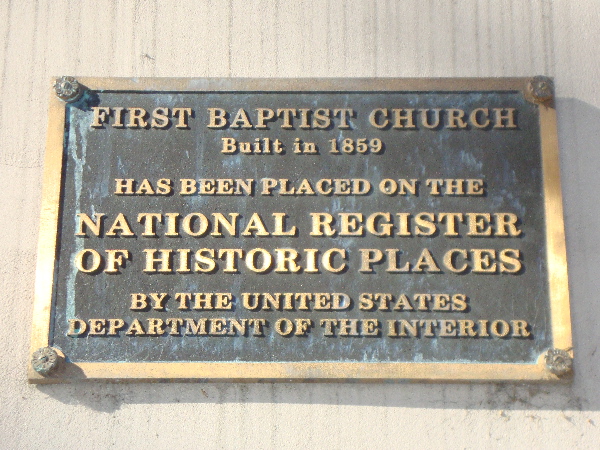
"Designed by English architect William Percival, First Baptist Church is a variant of the Gothic Revival style. The church is a symmetrical brick structure stuccoed and scored to give the appearance of stone. The building features an entrance tower with tall pinnacles and a 160-foot-tall spire. It is one of the four ecclesiastical anchors of Union (Capitol) Square."
-- Source
"When the Baptist church in Raleigh was organized in 1812 on the second floor of the original state Capitol building, there were 23 charter members—9 white and 14 black. In 1868 there was a peaceful separation of the two groups when the newly emancipated members established their own congregation.
Using the Bible as its sole guide for faith and practice, the first statement of beliefs of the church in 1812 consisted only of selected passages of scripture. Worship services and styles were in keeping with the customs of the culture at the time. Robert Daniel was the first pastor, and the first meeting-house was constructed in 1816 on South Person Street when Josiah Crudup was pastor.
Thomas Crocker became pastor of the church in 1821 and baptized Lucinda Briggs in 1822, reportedly by breaking ice in the river during the midst of winter. The membership grew to a total of 224 in 1826. A new building was completed and dedicated in 1840 on the site where First Baptist Church, Wilmington Street, is now located. Thomas Meredith (namesake of Meredith College), editor of the Biblical Recorder and a member of the church, was the dedication speaker. The first president of the Baptist State Convention of N. C., organized in 1830, was Patrick W. Dowd, pastor of our church.
The church suffered internal difficulties in the 1830s and nearly died, but the faithfulness of a few members preserved the church, and in the 1850s, the congregation experienced rapid growth and renewed vitality under the leadership of Pastor Thomas E. Skinner, who led the church to construct the present sanctuary in 1859. The lower level of the building was used as a Confederate hospital during the war between the states."
-- Source
According to the following information on a National Park Service website, the First Baptist Church (1859) is a contributing building within the historic district:
"The Capitol Area Historic District is a blend of architecture, landscape design and civic art, embodying more than 200 years of local history. Once the geographical center of the city, the area remains Raleigh's historical heart. The district takes its name from its pre-eminent feature. When the streets of Raleigh were laid out in 1792, Union (now Capitol) Square--the site of the State House--was placed at their core. The street grid is the historic district's oldest design legacy.
The city's earliest surviving buildings stand just east of the square. Haywood Hall, built c. 1799, rises on a large landscaped lot that recalls the house's once semi-rural setting. Opposite it is the White-Holman House (c. 1799, with a late 19th-century addition), containing some the city's finest Federal-style interior woodwork. Nearby is the brick State Bank of North Carolina (1813), the state's oldest extant financial building. The collection of early 20th-century residences and apartments built between reflects the downtown area's subsequent urbanization.
Government buildings and churches dominate the district's central portion. The granite, Greek Revival-style Capitol, completed in 1840, stands in the center of the Capitol Square, its cruciform design aligning with the city's four axial streets. Dotting the surrounding lawn are more than a dozen monuments honoring North Carolina soldiers and statesmen, framed by the 1928 Olmstead Brothers landscape plan and ancient trees. Facing the Capitol are six large government buildings, most with granite facades echoing the character of the Capitol. The oldest (1888) is the Supreme Court and State Library Building (now the Labor Building ); the newest, the Highway Building (1950). Others date from the early 20th century, reflecting the state's growth during that era.
Anchoring the corners of the square are four churches, two of antebellum Gothic Revival style: Christ Episcopal Church (1854) and the First Baptist Church (1859). The Romanesque First Presbyterian Church dates from 1900; the Gothic-style First Baptist Church on Wilmington Street was built in 1904 by black members of the other First Baptist Church. To the west, the district also encompasses All Saints Chapel (1875) and the associated Church of the Good Shepherd (1914), plus the Cathedral of the Sacred Heart (1922), with its attendant rectory (1917), convent (1927) and school (1938).
Examples of adaptive use attest to the district's on-going evolution. Among them are the 1887 Raleigh Water Tower, now serving as the chapter headquarters of the American Institute of Architects, and the 1903 Dr. A. W. Goodwin House, a classically-styled mansion that today houses the Democratic Party's state headquarters. While new parking lots and peripheral construction have had their effects, the district retains a high level of architectural integrity. Its early buildings and mature streetscape provide a visual counterpoint to the city's present burgeoning growth, recalling the tree-shaded small town that North Carolina's capital once was.
The Capitol Area Historic District surrounds the Capitol building, including Edenton, Blount, Morgan, Wilmington, Salisbury, Hillsborough, McDowell sts. and New Bern Ave. The Capital Area Visitor Services is located in the lobby of the North Carolina Museum of History at 5 East Edenton St. and is open Monday-Friday from 8:00am to 5:00pm, Saturday from 10:00am to 4:00pm, and Sunday from 1:00pm to 4:00pm; closed major holidays. Call 919-807-7950 or visit the center's website for further information."
-- Source